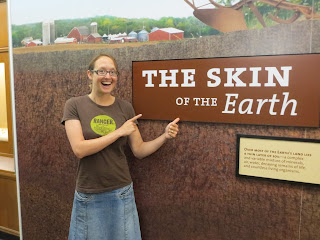This Summer, I visited a friend in Minneapolis and made sure to make a stop at the University of Minnesota Bell Museum of Natural Science to check out Dig It! Secrets of Soil. The exhibit, organized by the Smithsonian Institute and supported as a traveling exhibition, offers a wealth of information and some hands-on activities examining this most precious of resource!
 |
| The three main components of soil: sand, silt and clay combine to form Loam - the farmer's dream! |
This display shows the way that water flows through soil, depending on the size of particles. Sand, being the largest particle, lets water run freely through while clay, the smallest particle, holds water. When gardening we ideally have a healthy mix of all particles - allowing for some water retention, but also needing air and space for roots to grow into the soil and water to release as to prevent 'choking' the roots.
 |
| A very cool look below the surface - what diversity exists just in our country! |
One of my favorite parts of the exhibit was this area, showing different soil samples from around the U.S. It's a great reminder of how diverse our Earth is, and what incredible history She has!
 |
| Soil, taken from Antigo, to show Wisconsin's beautiful silt loam - prime soil for agrictulture |
Wisconsin's State Soil, officially named in 1983, is Antigo Silt Loam, shown above. Though Wisconsin has over 500 soil types, the Antigo Silt Loam is what has made our state a productive agricultural hub of the midwest. Over 10,000 years ago glacial meltwaters deposited sand and gravel in our area which now forms the lower subsoil and substratum (2-3 feet under ground). Strong winds and further melting of glaciers then brought in the silt and loamy outwash which covered the lower sand/gravel deposits. These two layers ensure good soil drainage, while the hardwood forests of northern Wisconsin helped to develop the beautiful topsoil which has fed thousands of farming families and their customers.
 |
| Caption reads: What is 45% minerals, 5% organic matter, 25% water, and 25% air? A midwestern farmer's dream - the ideal loamy soil. |


No comments:
Post a Comment